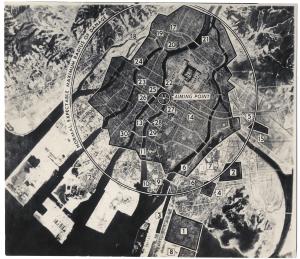
BOSTON (AP) — It's just a few cryptic notations on a badly yellowed sheet of paper, but it changed the course of world history.
An original copy of the operations order for dropping an atomic bomb on Hiroshima on Aug. 6, 1945, is on display at the Museum of World War II as the 70th anniversary of the attack is marked Thursday. It is being featured there along with other related artifacts.
The Hiroshima bombing and its aftermath ultimately claimed about 140,000 lives, helping to draw to a close the deadliest conflict in history and, for better or worse, usher in the atomic age.
"To me, it's a glimpse into what went on that day," says Kenneth Rendell, founder of the private museum located in the Boston suburb of Natick. "The average person does not realize what one of these missions would be like. I think it just humanizes everything."
The simple, careworn document bears little indication of the importance of the mission. There's no direct mention of the Enola Gay, the B-29 bomber that dropped the bomb, or of the infamous bomb itself, codenamed "Little Boy."
Under a section meant to describe what types of bombs the plane would be carrying, the order bears just one word: "special." The Enola Gay is listed only by its identification number, 82, and the last name of its pilot, Paul Tibbets.
The operations order is a basic sequence of events for crew members on the nine planes involved in the bombing, from when to attend prayer services, rise from bed, eat meals, attend briefings and finally take flight for Japan.
The museum, which Rendell established in 1999, also has a copy of a similarly nondescript order for the atomic bomb dropped on Nagasaki three days later on Aug. 9. That blast and its aftermath claimed another 80,000 lives, prompting Japan to surrender days later on Aug. 15.
Rendell, who has amassed a considerable trove of World War II related artifacts for his museum, says he purchased the operations orders over two decades ago from the family of Jacob Beser, a radar and electronics specialist who was the only man to have flown both bombing missions. Beser died in 1992.
Other items in the exhibit also were purchased from the family of crew members.
For example, there are some personal effects from Enola Gay's navigator Theodore "Dutch" VanKirk, who was the last surviving member of the crew before he died last year at the age of 93. Among them are VanKirk's headset, bible and navigator's sextant, which he used to plot the course to Hiroshima.
There also is a handwritten missive that George Caron, the Enola Gay's tail gunner, penned to his wife upon returning from the successful mission.
"It seems our crew and airplanes made history or something," he writes. "When they let us write about it from here, I'll be able to tell you all about it. Our picture will probably be all over the states before we can say anything." PHOTOS



